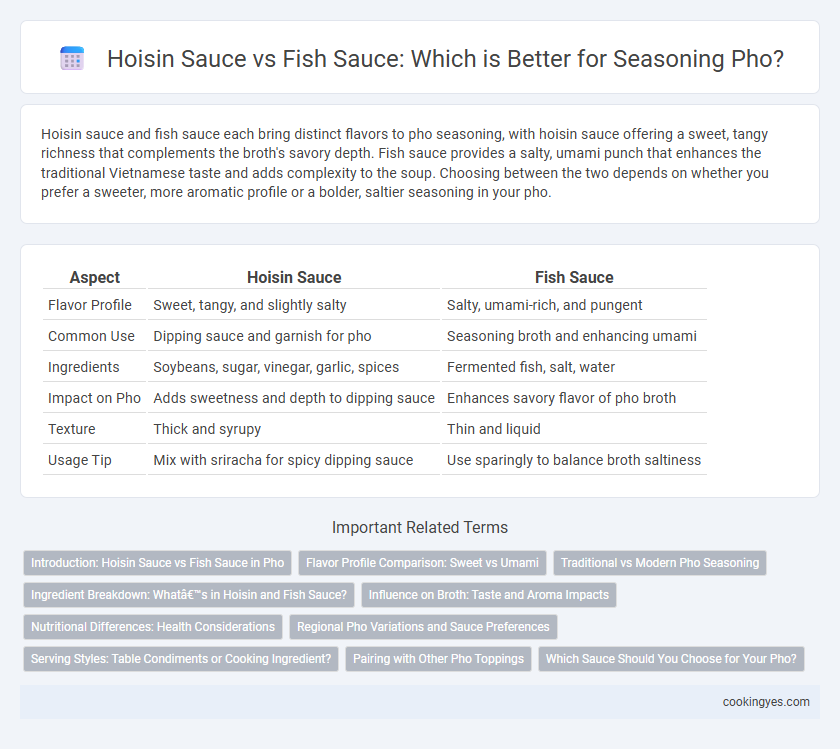Hoisin sauce and fish sauce each bring distinct flavors to pho seasoning, with hoisin sauce offering a sweet, tangy richness that complements the broth's savory depth. Fish sauce provides a salty, umami punch that enhances the traditional Vietnamese taste and adds complexity to the soup. Choosing between the two depends on whether you prefer a sweeter, more aromatic profile or a bolder, saltier seasoning in your pho.
Table of Comparison
| Aspect | Hoisin Sauce | Fish Sauce |
|---|---|---|
| Flavor Profile | Sweet, tangy, and slightly salty | Salty, umami-rich, and pungent |
| Common Use | Dipping sauce and garnish for pho | Seasoning broth and enhancing umami |
| Ingredients | Soybeans, sugar, vinegar, garlic, spices | Fermented fish, salt, water |
| Impact on Pho | Adds sweetness and depth to dipping sauce | Enhances savory flavor of pho broth |
| Texture | Thick and syrupy | Thin and liquid |
| Usage Tip | Mix with sriracha for spicy dipping sauce | Use sparingly to balance broth saltiness |
Introduction: Hoisin Sauce vs Fish Sauce in Pho
Hoisin sauce and fish sauce each play distinctive roles in pho seasoning, enhancing the dish's complex flavor profile. Hoisin sauce offers a sweet, slightly tangy taste that complements the savory broth, often added by diners to customize their bowls. Fish sauce provides a bold umami depth with salty and slightly pungent notes, integral to the authentic Vietnamese pho experience.
Flavor Profile Comparison: Sweet vs Umami
Hoisin sauce imparts a sweet, tangy flavor with hints of spice, enriching pho with a smooth, caramelized depth. Fish sauce delivers a robust umami punch, adding savory complexity and enhancing the broth's natural flavors. Combining both sauces balances sweet and umami notes, creating a layered, harmonious pho experience.
Traditional vs Modern Pho Seasoning
Traditional pho seasoning relies heavily on fish sauce, providing a distinct umami depth essential to authentic Vietnamese broth, while modern pho often incorporates hoisin sauce as a sweeter, nuanced alternative or garnish. Fish sauce, made from fermented anchovies, delivers savory complexity and a salty tang that defines classic pho flavor profiles. Hoisin sauce, though less conventional in the broth, enhances the dish when added as a dip or topping, balancing spices with its rich sweetness in contemporary pho presentations.
Ingredient Breakdown: What’s in Hoisin and Fish Sauce?
Hoisin sauce contains fermented soybeans, sugar, vinegar, garlic, and various spices, providing a sweet and tangy flavor profile ideal for adding depth and complexity to pho. Fish sauce is made from fermented anchovies and salt, offering a distinct umami and salty taste that enhances the broth's savory richness. Understanding these ingredient differences helps customize pho seasoning to balance sweetness and umami according to personal preference.
Influence on Broth: Taste and Aroma Impacts
Hoisin sauce adds a sweet, garlicky depth that enhances the broth's richness, creating a slightly thicker and more complex flavor profile. Fish sauce contributes a savory, umami intensity with a subtle briny aroma, intensifying the broth's authentic Vietnamese character. Balancing hoisin and fish sauce results in a harmonious blend that elevates both the taste and aromatic complexity of pho broth.
Nutritional Differences: Health Considerations
Hoisin sauce contains higher sugar and sodium levels compared to fish sauce, impacting blood sugar and blood pressure regulation. Fish sauce offers a low-calorie source of protein and essential amino acids, supporting muscle health and metabolism. Choosing between the two depends on dietary goals, with fish sauce providing more nutritional benefits for heart health and weight management.
Regional Pho Variations and Sauce Preferences
Northern Vietnamese pho typically favors fish sauce for its authentic, savory depth, enhancing the clear, subtle broth without overpowering the delicate flavors. In contrast, Southern pho often incorporates hoisin sauce, adding a sweeter, richer dimension that complements the heartier, spicier broth typical of the region. These regional nuances highlight how sauce preferences reflect local tastes and contribute to the distinct identities of northern and southern pho.
Serving Styles: Table Condiments or Cooking Ingredient?
Hoisin sauce is primarily served as a table condiment for pho, allowing diners to customize their bowls with its sweet and tangy flavor. Fish sauce is commonly used as a cooking ingredient, infused during broth preparation to enhance umami depth and authenticity. Both condiments contribute uniquely, with hoisin providing a finishing touch at the table and fish sauce enriching the foundational taste of pho.
Pairing with Other Pho Toppings
Hoisin sauce adds a sweet and savory depth that pairs well with rich pho toppings like beef slices and meatballs, balancing their robust flavors. Fish sauce provides a salty, umami punch that complements fresh herbs such as Thai basil and cilantro, enhancing the broth's complexity. Combining both sauces allows for a customized pho experience, harmonizing the sweet, salty, and aromatic elements alongside bean sprouts and lime wedges.
Which Sauce Should You Choose for Your Pho?
Choosing between hoisin sauce and fish sauce for pho seasoning depends on the flavor profile you prefer. Fish sauce offers a salty, umami depth that enhances the broth's authenticity, while hoisin sauce adds a sweet, tangy richness often used as a dipping condiment or garnish. For a traditional pho experience, fish sauce is essential, but incorporating hoisin sauce can create a balanced and personalized flavor.
Hoisin sauce vs fish sauce for pho seasoning Infographic

 cookingyes.com
cookingyes.com